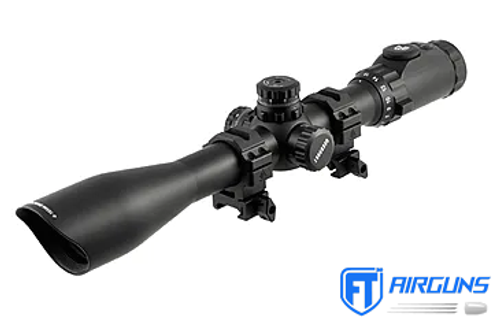Best Features Designed for Varmint/Predator Hunting • Built on TRUE STRENGTH® Platform, Completely Sealed and Nitrogen Filled, Shockproof, Fogproof and Rainproof • Innovative EZ-TAP® Illumination Enhancing (IE®) System with Red/Green Dual-Color Mode and 36 Color Multi-Color Mode to Accommodate All Weather/Light Conditions (US PAT. 8437079; EU PAT. EP2520894) • 1-Click High-tech Illumination Memory Feature Gets You Right Back to the Color/Brightness Setting Last Used • Premium Zero Locking and Zero Resetting Target Turrets with Most Consistent and Precise 1/4 MOA per Click Windage/Elevation Adjustment • Emerald Coated Lenses to Achieve Maximum Light Transmission for Best Clarity • Mil-dot Range Estimating Reticle for Most Optimal Aiming and Shooting Performance • Parallax Adjustable from 5 Yds Close Range to Infinity • Complete with RGWM-25H4 Picatinny/Weaver Rings and High Quality Flip-open Lens Caps
| 4 - 16X |
| 1 Inch |
| 40 mm |
| 23' - 6' |
| 3.2" - 3" |
| 10 mm - 2.5 mm |
| 1/4" |
| 370 mm |
| 22.3 oz |
| 5 Yds - Infinity |
| CR2032 3V |
|
 |
| 370 mm |
| 153 mm |
| 62 mm |
| 58 mm |
| 93 mm |
| 126 mm |
| 41 mm |
|
52 mm
|
|
|
RANGE ESTIMATING SCOPE: Leapers/UTG started introducing mil-dot reticle optics from as early as 2003, pioneering the Range Estimating concept as a useful tool for hunters and shooters around the world. Today, mil-dot reticle is widely accepted and used in this industry. Leveraging our years of experience in this area, we developed and refined the unique Tactical Range Estimating(TRE) mil-dot reticle and offer this feature in almost all of our optics. With some patient learning and practice using our TRE, shooters can enhance accuracy and performance in ways not imagined before. 9 Dot TRE Mil-Dot: Nine dots are featured spanning each side of the reticle's origin in the left, right, up, and down directions. These provide 18 points of aim across for both windage and elevation. When including the reticle's origin and the inner edges of the reticle's outer duplex a total of 21 points of aim are available. 6 Dot TRE Mil-Dot: Six dots are featured spanning each side of the reticle's origin in the left, right, up, and down directions. These provide 12 points of aim across for both windage and elevation. When including the reticle's origin and the inner edges of the reticle's outer duplex a total of 15 points of aim are available. 4 DOT TRE Mil-Dot: Four dots are featured spanning each side of the reticle's origin in the left, right, up, and down directions. These provide 8 points of aim across for both windage and elevation. When including the reticle's origin and the inner edges of the reticle's outer duplex a total of 11 points of aim are available. For 4 DOT TRE Mil-dot scopes with a floating reticle, sans the outer duplex, a total of 9 points of aim are available. Mil-Dot Range Estimating: Range estimating requires common knowledge/experience about your target's actual width or height. Set your scope at 10X or the proper power, depending on the scope. View the target through the scope. Place the center of the dot against one edge of the target and measure to the opposite edge of the target. Once the target has been measured in mils, depending on the scope model, a formula is available to estimate the distance of the target. Each scope will come with a pre-calculated mil-dot table of most used distance estimates to aid the user. Mil-Dot Range Estimating Example: For example, based on past experiences, the length of a known animal from shoulder to tail is 40 inches (1.016 meters), and we see through a scope at, for example, 9X to find that the animal occupies 9 mils. Therefore, the distance can be derived from using the following formula - Height or Width of Target in Meters x 1,000 Magnification x = Range in Meters (1 M = 1.0936 Yards) Height or Width of Target in Mils 10 Hence, (1.016 x 1,000/9) X (9/10 ) = 101.6 meters (110 yds). Armed with this knowledge, you can compensate for the bullet’s drop accordingly and make “great things happen”!
















